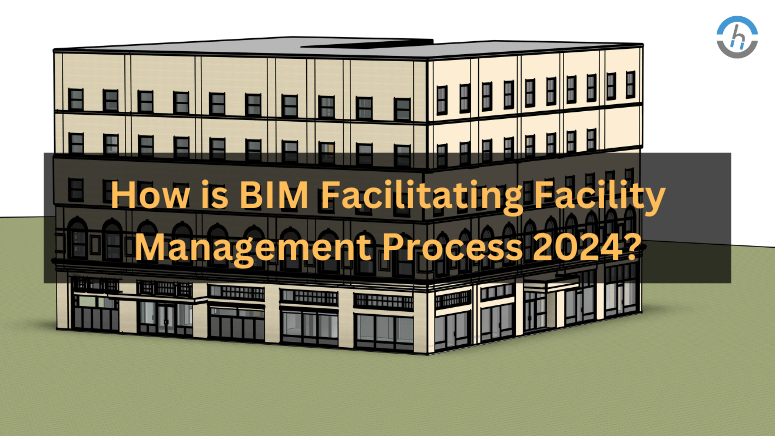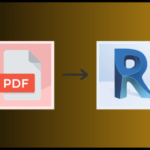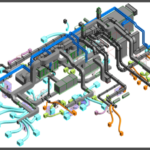Quick summary: Look at BIM engagement in 2024 BIM Facilitating Facility Management, which aims to increase the efficiency, precision, and collaboration of everyone in each stage of the buildings.
In the world of recent civil engineering and architecture, BIM, aka Building Information Modelling, has become a ground-breaker by transforming the way of designing, constructing, and managing the spaces used to build projects.
It was initially introduced to support design and construction, the influence of BIM on the operational process of the facility has been an even more exciting avenue, as it delves deeper into a facility’s lifecycle, and encompasses the mission of reducing cost for resource consumption while facilitating the maximization of through-put and efficiency at the same time.
What is BIM?
To get started on BIM application in facility management, we prefer that we first understand what BIM is at the start and why it has become an industry standard. Building Information Modeling (BIM) is a process that may be supported by various means, such as tools, technologies, and even contracts, that deals with the creation, control, and management of digital documents that contain the information of the physical and the functional characteristics of places.
The Foundation of BIM
Its core is the intelligent 3D models, which create a virtual construction process in which architects, engineers, and contractors receive a lot of information on how the building will perform well even before taking the trowel to the cement. Its virtual replicas give stakeholders a more transparent and closer look at the project’s entire life cycle than the reality.
Benefits of BIM in Construction
From the aspect of cooperation and coordination to the enhanced perception of more details of the structure’s aesthetics and function, BIM’s positive effects are diverse and comprehensive.
This way, BIM enables construction teams to make a more visual representation of the design, and in turn, the whole process will be smoother, with fewer errors and resources better allocated.
What is BIM Facility Management?
Communication is present throughout the entire life cycle of the facility, which extends the BIM benefits from construction into the operation phase. Implicitly, it relies on 3D model data to assist facility managers in determining the best methods and technology to use in building operations enhancements and repairs.
In the long run, it works on repair and operations more efficiently and sustainably across the building’s lifecycle. Consequently, the BIM model that the team used to develop the building is converted into a tool that facility management teams will use to keep tabs on and control structural maintenance work, building occupancy levels, and energy consumption, among other critical functions.
Integration of Data and Systems
The BIM in facility management is made up of the integration of numerous systems, like the seamless data arrangement that presents a single platform for the derivation of insights and information. Through BIM, facility managers can access a static source containing all the details about the building, specific parts, and a relational information record of the activities that have happened to each asset.
Exploring the Significance of BIM in Facility Management
At the facility level, one addresses a large number of topics, such as the tactics of strategic planning and day-to-day operations. Moreover, BIM assists in this sphere by providing a database structure for the information and by visualizing systems with pictures to make even the most complex operations easier.
The Digital Twin
BIM essentially creates a digital twin, or a virtual representation, of a physical building. This twin mirrors the facility, enabling managers to monitor and control the building’s various systems in real-time. It also provides alerts and predictive modeling capabilities so managers can anticipate issues before they occur.
Key Benefits of BIM in Facility Management
The benefits of applying BIM in the realm of facility management are, as a matter of fact, doubled. They improve the efficiency in forecasting maintenance activities, make spaces more usable, and enable a better profile for the building energy and materials use.
BIM Tools for Facility Management
Many software tools exist with the purpose of BIM execution during the facility management phase. All of them are endowed with specific sets of characteristics that deal with separate problems.
Overview of BIM Software
When it comes to the BIM software sphere, Autodesk, Revit and AutoCAD, which are usually used in AEC industries, are definitely the most prominent ones. Similarly, programs such as ArchiCAD, Bentley Systems, and Vectorworks have established market leaders with advanced BIM capabilities throughout the globe.
Make the Final Choice on the BIM Tool
The availability of BIM tools for facility management varies depending on various factors, such as the nature of the facility, the size of the facility management team, and the existing software infrastructure. There are many different types of tools with their strong aspects—space planning, asset management, or building performance analysis.
BIM in Action: Facility Management Processes
To gain a comprehensive understanding of Building Information Modeling (BIM) and its significant role in facility management, exploring its application within essential processes provides valuable insights. By delving into how BIM interfaces with key operations and workflows, we unveil its transformative potential in optimizing facility performance and enhancing operational efficiency.
Maintenance Management
The model of the BIM can be added with category-specific data, such as installation details, correction history, and recommended service cycle. Such a practice gives opportunities for both proactive and reactive strategies to be designed in the best possible way and to avoid any unnecessary outages and costs.
Space Planning and Utilization
A BIM platform allows managers to see dynamic space allocation in 3D, identifying the current and future utilization. It aids the fast reorganization process, shows areas that can’t be used properly, and helps obtain better space distribution over time.
Energy Management
BIM works according to the building’s actual data to manage the energy more precisely. It provides for the detection of energy wasters, implementation of energy savers, and making a suitable environment for community dwellers.
The Impact of BIM on Facility Management
The embodiment of the Building Information Model in facility management procedures leads to the assessment of many effects on building management and operations.
Operational Efficiency
BIM’s complete information makes it easier to perform maintenance and operational tasks, reduces downtime, and improves facilities management.
Cost Reduction
BIM’s predictive maintenance leads to a decline in unexpected repair expenses and the use of resources that are planned and managed to achieve an optimum. On the other hand, an effective use of intelligent space helps a facility to decrease the building and related expenses.
Eco-Friendliness
The BIM’s energy management capabilities contribute to a leaner and greener approach during operations. Through the assessment and modeling of buildings and the implementation of efficient energy processes, BIM helps address sustainability objectives by decreasing the impact on the environment.
Future of BIM in Facility Management
In the future, BIM may play a different role in facility management. The industry acknowledges the importance of a management approach that is rich in data and intelligence that will, in return, adapt the environment to recent technologies.
Integration with IoT and AI
The integration of BIM with IoT and AI in the facility management field is going forward. Combined, they would foster even more profound automation and make the predictive capabilities more sophisticated.
Continued Software Development
BIM software systems will be further developed to be able to perform complex purposes of recording, interfering, and reporting management in all aspects of building management. As such, software solutions will be more user-friendly and easier to use, and they will be accessible to a more significant segment of end-users.
Standardization and Regulation
The sector may, therefore, expect uniformity in the BIM systems and building regulations, whereas its ongoing uptake may prove to be a contributory factor for the improvement of facility management processes.
Conclusion
The influence of BIM on facilities management is one of the facets of construction technology development that is awesome to witness in action. Introducing BIM into operations makes it feasible for processes to be smooth, which is another way to have fewer costs and manage resources more efficiently. The adoption of BIM is the key element for coming-of-age facility management to grow, evolve, and get the desired outcome – try it, make the needed changes, & enjoy the benefits.





